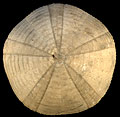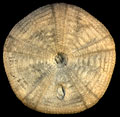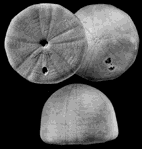The Echinoid Directory
Camerogalerus Quenstedt, 1873, p. 411
[=Pithodia Pomel, 1883, p. 75 (objective); =Pseudodiscoides Lambert & Thiery, 1914, p. 282 (objective); = Dixonia Wagner & Durham, 1964, p. 170, type species Discoidea minima Desor, 1842 ]
| Diagnostic Features |
|
|---|---|
| Distribution | Early Cretaceous (Aptian) to Late Cretaceous (Maastrichtian), Europe and North Africa. |
| Name gender | masculine |
| Type | Galerites cylindricus Lamarck, 1816, p. 23, by monotypy. |
| Species Included |
|
| Classification and/or Status |
|
| Remarks |
|




